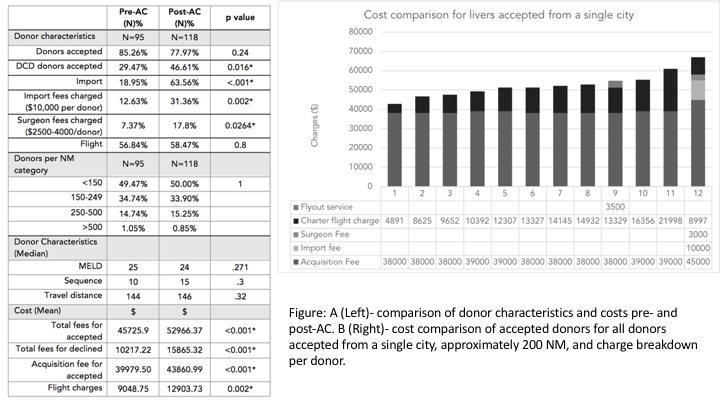The Unintended Financial Consequences of Acuity Circles for Liver Allocation – Two-fold Increase in Import Fees and Higher Organ Acquisition Cost Despite Unchanged Travel Patterns
Abdominal Transplant Surgery, Baylor University Medical Center, Dallas, TX
Meeting: 2021 American Transplant Congress
Abstract number: 188
Keywords: Allocation, Economics
Topic: Clinical Science » Liver » Liver: MELD, Allocation and Donor Issues (DCD/ECD)
Session Information
Session Name: MELD, Allocation and Donor Issues
Session Type: Rapid Fire Oral Abstract
Date: Sunday, June 6, 2021
Session Time: 6:00pm-7:00pm
 Presentation Time: 6:35pm-6:40pm
Presentation Time: 6:35pm-6:40pm
Location: Virtual
*Purpose: The recent initiation of acuity circles (AC) as the basis for liver allocation is associated with broader sharing and potentially greater travel and increased costs for organ acquisition. We compare liver acquisition costs before and after AC-based liver allocation.
*Methods: We collected the OPO and flight invoices for all liver donors for our transplant center pre-AC (7/1/2019-2/3/2020) and post-AC (2/4/2020-10/30/2020).
*Results: (Figure A) Comparing expenses from the post-AC to pre-AC period, there was a >2-foldincrease both in % donors incurring an import fee (31.4% vs 12.6%, p<0.01), and surgeon fee (17.8% vs 7.4% p<0.01). Costs were significantly higher in the post-AC period compared to pre-AC, as total cost per accepted donor increased 16%(mean $52,966 vs $45,725, p<0.01), cost per declined donor increased 55%(mean $15,865 vs 10,217, p<0.01) acquisition fees increased 10%(mean $39,979 vs 43,860, p<0.01) and flight expenses increased 43%(mean $12,903 vs $9,048 p<0.01). The donor charges themselves varied widely. The highest and lowest donor costs for separate donors at the exact same donor city 200 NM from our center, differed by >$20,000 (Figure B)
Comparing donor parameters in the post-AC to the pre-AC period, there was no change in the Median MELD Score (24 vs 25, p=0.271) or match run sequence (15 vs 10, p=0.305), although the DCD acceptance rate was significantly higher (46% vs 29%, p=0.016).
Comparing travel patterns, there was no difference in median nautical miles travelled (146 vs 144, p=0.324) or percent of donors requiring flights (58% vs 57%, p = 0.8). There was no difference in the donor acceptance rate and most donors were within 150 NM.
*Conclusions: Post-AC, our center had a higher % of donors incurring an import fee of $10,000, and surgeons fee ranging from $2,500-$4,000, as well as increased total costs for accepted donors (+16%), declined donors (+55%), acquisition fees (+10%) and flight fees (+43%). The unintended consequences of these ballooning costs of liver allocation needs urgent regulation by UNOS/OPTN in a similar vein to kidney acquisition, so as to ensure this change in AC allocation doesn’t threaten the financial viability of liver transplant programs.
To cite this abstract in AMA style:
Wall A, Asrani S, McKenna G, Martinez E, Ruiz R, Fernandez H, Bayer J, Gupta A, Onaca N, Goldstein R, Trotter J, Testa G. The Unintended Financial Consequences of Acuity Circles for Liver Allocation – Two-fold Increase in Import Fees and Higher Organ Acquisition Cost Despite Unchanged Travel Patterns [abstract]. Am J Transplant. 2021; 21 (suppl 3). https://atcmeetingabstracts.com/abstract/the-unintended-financial-consequences-of-acuity-circles-for-liver-allocation-two-fold-increase-in-import-fees-and-higher-organ-acquisition-cost-despite-unchanged-travel-patterns/. Accessed December 19, 2025.« Back to 2021 American Transplant Congress

